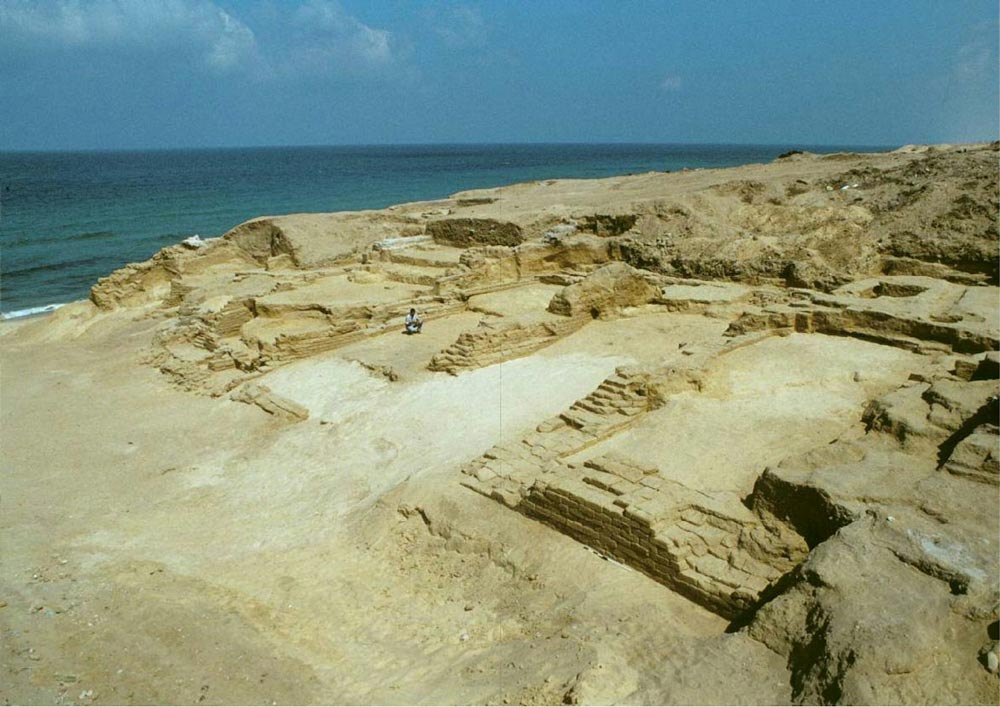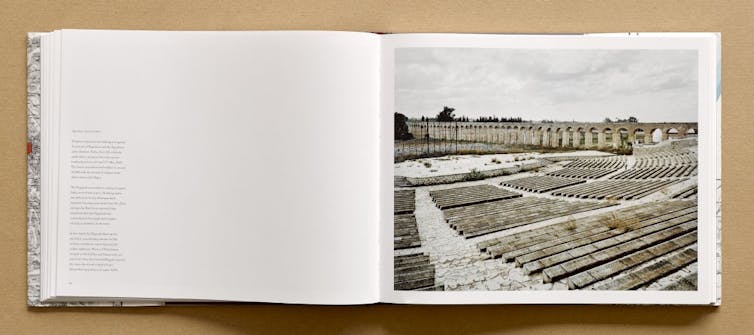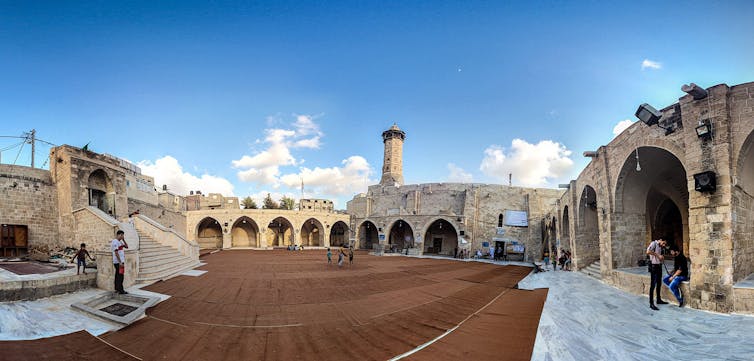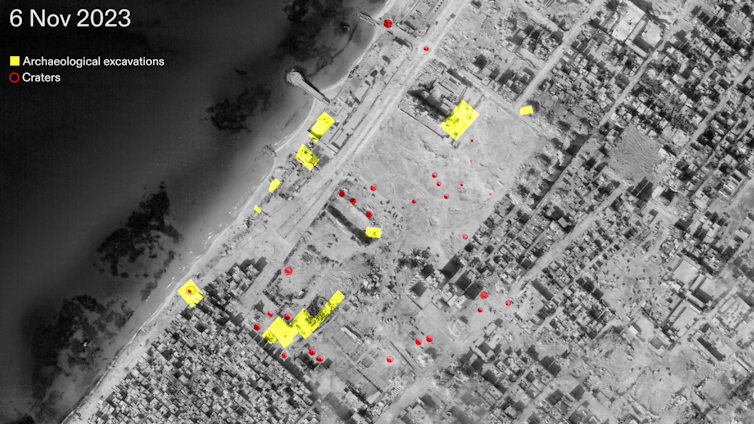
By Pilar Montero Vilar
In 2016, British photographer James Morris published Time and Remains of Palestine. The images in this book bear witness to an absence of architectural monuments, and to the invisible moments of history buried in the rubble and wastelands of Palestine.

Jamesmorris.info
Situated at the crossroads between Asia and Africa, Palestine has always been an area of great strategic importance, and it has been populated by various civilisations throughout history. Its emptiness can therefore only be explained by a false history, one that stems directly from the Israeli settler movement, which seeks to destroy the material traces of other cultures that point to a much more complex past than they would like to admit.
This complexity has been painstakingly proven in a Forensic Architecture report on an archaeological site known as Anthedon Harbour, Gaza’s old maritime port, which was first inhabited somewhere between 1100BC and 800BC.
October 2023: human cost takes precedence over cultural losses
On 7 October 2023, the day after the 50th anniversary of the Yom Kippur war, Israelis celebrated the Simchat Torah holiday. While this was happening, the wall built by Israel inside the Gaza Strip was breached by more than 1,200 Hamas members in a surprise attack. They kidnapped more than 200 people, and left at least 1,200 dead and almost 3,500 injured.
Israel swiftly declared a state of war for the first time since 1973. The conflict, which has just passed its one year mark, has become an unprecedented humanitarian catastrophe for 2.3 million Palestinians. The numbers are appalling: over 41,000 dead, including more than 14,000 children, almost 100,000 wounded and more than two million displaced.
A month after the outbreak of the war, UNESCO, at its 42nd General Conference, stated that “the current destruction and eradication of culture and heritage in Gaza is yet to be determined, since all efforts are now being concentrated on saving human lives in Gaza.”
Monitoring the disaster
The scale of Gaza’s humanitarian catastrophe has meant that the extensive destruction of significant elements of Palestinian history and identity could easily be overlooked. However, in April 2024, the United Nations Mine Action Service estimated that “every square metre in Gaza impacted by the conflict contains some 200 kilogrammes of rubble.”
Cultural property has been a target of the Israeli offensive since the beginning of the conflict and, as early as November, the devastation of the cities of northern Gaza far exceeded that caused in the infamous bombing of Dresden in 1945. We cannot forget that the Gaza Strip is just a narrow area of coastal land measuring some 365 km², rich in archaeological and historical sites, that the international community has recognised as occupied territory since 1967.
Research over the last century has counted at least 130 sites in Gaza that Israel, as an occupying power, is obligated to protect under international law along with the rest of the area’s cultural and natural heritage. These obligations are laid out in the following conventions: Convention on the Prevention and Punishment of the Crime of Genocide (1948); the Geneva Conventions (1949) and their annexes, and the Hague Convention for the Protection of Cultural Property in the Event of Armed Conflict (1954).
As of 17 September 2024, UNESCO has verified damage to 69 sites: 10 religious sites, 43 buildings of historical and artistic interest, two repositories of movable cultural property, six monuments, one museum and seven archaeological sites. Other reports give a much higher number of affected sites. These assessments are made in very difficult situations, in the midst of constant bombardment, thanks to testimonies and studies on the ground and supported by satellite images.

Alaa El halaby/Wikimedia Commons, CC BY-SA
One especially striking example of a site reduced to rubble is the Great Mosque of Gaza, considered by many to be the oldest mosque in the territory and a symbol of resilience. The Church of Saint Porphyrius – the oldest Christian church in Gaza, built by the Crusaders in 1150 – has also been hit by Israeli airstrikes.
While Israel is not a member of UNESCO – it left in 2018, when the Trump administration pulled the US out – it is still obligated under the 1954 Hague Convention to preserve cultural property. Article 4 of the Convention states that:
“The High Contracting Parties undertake to respect cultural property situated within their own territory as well as within the territory of other High Contracting Parties by refraining from any use of the property and its immediate surroundings or of the appliances in use for its protection for purposes which are likely to expose it to destruction or damage in the event of armed conflict; and by refraining from any act of hostility, directed against such property. ”
The Hague Convention turned 70 in 2024, but cultural heritage sites are still woefully underprotected from armed conflict around the world.
Humanitarian and cultural genocide
The destruction of Gaza’s cultural heritage is intertwined with the ongoing humanitarian crisis. This link is recognised by the International Criminal Court, which states that:
“Crimes against or affecting cultural heritage often
touch upon the very notion of what it means to be human, sometimes eroding
entire swaths of human history, ingenuity, and artistic creation.”
Many independent reports and articles have begun to break down specific elements of the destruction in Gaza, speaking not just of genocide, but also of cultural genocide, urbicide, ecocide, domicide and scholasticide.
On 29 December 2023, the Republic of South Africa brought a case before the International Court of Justice, accusing Israel of violating its obligations under the 1948 Convention on Genocide with regard to Palestinians in Gaza.
Among the evidence supporting South Africa’s claim, Israel is accused of attacking infrastructure to bring about the physical destruction of the Palestinian people, with their attacks leaving some 318 Muslim and Christian places of worship in ruins, along with numerous archives, libraries, museums, universities and archaeological sites. This is all in addition to destroying the very people who created Palestine’s heritage.
Gaza: one big military target
In her report, published on 1 July 2024, Francesca Albanese, the UN Special Rapporteur on the situation of human rights in the Palestinian territories, highlights how Israel has turned Gaza in its entirety into a “military target”. The Israeli military arbitrarily links mosques, schools, UN facilities, universities and hospitals to Hamas, thus justifying their indiscriminate destruction. By declaring these buildings legitimate targets, it does away with any distinction between civilian and military targets.

Forensic Architecture, 2023; Satellite image: ©️ Planet Labs PBC, 2023
Although Israel’s attacks against the cultural heritage of Palestine are not a new phenomenon, the current destruction in Gaza’s city centres is unprecedented.
As far as Albanese is concerned, Israel is trying to mask its intentions by using the terminology of international humanitarian law. In doing so, it justifies the systematic use of lethal violence against any and all Palestinian civilians, while simultaneously pursuing policies aimed at the widespread destruction of Palestinian cultural heritage and identity.
Her report unequivocally concludes that the Israeli regime’s actions are driven by a genocidal logic, a logic that forms an intrinsic part of its colonisation project. Its ultimate aim is to expel the Palestinian people from their land, and to wipe away any trace of their culture and history.
![]()
Pilar Montero Vilar is Professor and principal researcher of the Observatory of Emergencies in Cultural Heritage, Complutense University of Madrid.





























Pogo says
@Pilar Montero Vilar
https://theconversation.com/destruction-of-gaza-heritage-sites-aims-to-erase-and-replace-palestines-history-240722
Very informative.
I hope you will employ your genius and expertise to a similar project engulfing 337 million Americans; and the continued existence of human life on earth.
richard polirer says
Pilar is sitting comfortably in Madrid, far from the fray. She ignores the fact that Hamas hides behind civilians and in so-called off-limits places, necessitating Israel’s search and destroy missions in its war to destroy Hamas. She is not fair and even handed, but rather a cheerleader for the Gaza Hamas terrorists and a biased prosecutor to the Israelis. Therefore, I discount anything she has to say. If your terrorist enemy is hiding in a mosque, a school, and archaeological site, or anywhere above or below ground, it is Israel’s OBLIGATION to root them out, regardless of their hiding place. Oh, and the comparison to Dresden is totally off the mark, as well. Pilar’s native country was neutral in WW II, had a fascist government for decades after its civil war of 1936-39, which saw the Luftwaffe bomb indiscriminately. Pilar doesn’t take cognizance of this, however. Her essay is flawed and deeply slanted.
DaleL says
The comparison with Dresden is somewhat on the mark. The refugees and civilians in Dresden were effectively hostages of the genocidal Nazi German government. At the same time that Dresden was bombed, millions of Jews were being systematically murdered. Similarly, the civilians and refugees in Gaza are effectively hostages of the genocidal Hamas terrorists. Hamas continues to attack Israeli civilians with indiscriminate rockets and assassins.
Mass bombing in WWII, (conventional explosives, incendiary, and nuclear), only ended when the war ended. Similarly, the destruction in Gaza could end almost immediately with the destruction of Hamas and the release of the remaining Israeli hostages. Hamas hides behind the civilians in Gaza. However, many if not most Gaza civilians are complicit with Hamas.
Pogo says
@FWIW
A man does not belong to the place where he was born, but where he chooses to die.
— Orson Welles
Kennan says
These people are targeted by the way. This is not a war. It’s never been a war. Yahoo called it a war, and thought he could do a genocide with that title. Even under war standards if this was a real war, he’d be breaking every rule there was. But as it stands, it’s just a straight genocide targeting children, women, and every infrastructure in Gaza. There is nothing left. 90% of Gazza is unlivable. At this point at cease fire is a joke. The US needs to stop all weapons and all money to Israel. It’s the only way the country could even have a chance of saving face , and not looking like the evil overlords we surely will be when the dust settles on this one. Mark my words.
DaleL says
It is bad, much of Gaza is in ruins. The estimate, according to an NPR story is that an estimated 60% of buildings have been damaged or destroyed, according to satellite data analysis. That is not 90%, but it is really bad. In addition, some of the buildings which have been damaged or destroyed were built with asbestos. There is also unexploded ordinance just waiting to go off. I am reminded of German cities in which periodically unexploded bombs from WWII are still being found.
Simply getting Israel out of Gaza is not a long term solution. In the vacuum of Israel’s withdrawal, Hamas would rise once more from the ashes. An international peace keeping force is needed. Preferably one led by a Muslim nation. In addition, a massive amount of aid is needed to rebuild.
Kennan says
Listen if we stopped giving weapons and bombs and planes and military munitions to Israel as well as paying $4 billion a year for Israel just to be Israel, then there is no Hamas. Hamas is a byproduct of Israel’s bull in the China shop occupation of Gaza. It’s subjugation of the Palestinian people since 1948. Its occupation of the Gaza trip since 1957. Since . It’s subjugation of the Palestinian people since 1948. It’s occupation of the Gaza trip since 1957. Since that time there have been several mowings of the lawn . Which are periodic bombing campaigns to keep Palestinians in compliance with their rules. Cut it anyway you like that is Apartheid. Hamas and Hezballah are not as much religiously, motivated, as you would think. Yes, they are religious, but they were formed and created by Israel’s occupation and America’s support of that occupation. Support that is unwavering while knowing what is being done to the Palestinian people over the years. Operation cast lead. Operation protective edge among others which alone were at least as bad as October 7. That does not condone October 7, but again October 7 didn’t happen in a vacuum and we have to take responsibility for what we see now. When you’re born into a concentration camp and treated as a second-class citizen, which is remarkable considering, what juice went through in World War II. Alas, the people that would remember those things are all dying. I guarantee you, Jews from World War II. Concentration camps would find what’s happening now absolutely appalling. Get out of Israel. Let them keep Israel proper. Let a conglomerate of nations get together rebuild Gazza, which would probably take 10 to 15 years considering all the rubble now that is there. 50,000,000 tons I might add. But at least do that and you’ve got a chance for peace in the Middle East. As far as two states solution is concerned Benjamin Netanyahu does not want that and he has said that several times. He wants to go on so he doesn’t end up in jail. He is broken every war crime law there is as well as the ethnic cleansing that is now going on. It’s very obvious and we have to take responsibility for what we have done.